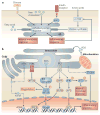Nutrient sensing and inflammation in metabolic diseases
- PMID: 19029988
- PMCID: PMC2814543
- DOI: 10.1038/nri2449
Nutrient sensing and inflammation in metabolic diseases
Abstract
The proper functioning of the pathways that are involved in the sensing and management of nutrients is central to metabolic homeostasis and is therefore among the most fundamental requirements for survival. Metabolic systems are integrated with pathogen-sensing and immune responses, and these pathways are evolutionarily conserved. This close functional and molecular integration of the immune and metabolic systems is emerging as a crucial homeostatic mechanism, the dysfunction of which underlies many chronic metabolic diseases, including type 2 diabetes and atherosclerosis. In this Review we provide an overview of several important networks that sense and manage nutrients and discuss how they integrate with immune and inflammatory pathways to influence the physiological and pathological metabolic states in the body.
Conflict of interest statement
The author(s) declare(s) competing financial interests: see web version for details.
Figures





References
-
- Hotamisligil GS. Inflammation and metabolic disorders. Nature. 2006;444:860–867. - PubMed
-
- Demas GE, Chefer V, Talan MI, Nelson RJ. Metabolic costs of mounting an antigen-stimulated immune response in adult and aged C57BL/56J mice. Am J Physiol. 1997;273:R1631–R1637. - PubMed
-
- Marti A, Marcos A, Martinez JA. Obesity and immune function relationships. Obes Rev. 2001;2:131–140. - PubMed
-
- Romanyukha AA, Rudnev SG, Sidorov IA. Energy cost of infection burden: an approach to understanding the dynamics of host-pathogen interactions. J Theor Biol. 2006;241:1–13. - PubMed
-
- Browning RC, Kram R. Energetic cost and preferred speed of walking in obese vs. normal weight women. Obes Res. 2005;13:891–899. - PubMed
Publication types
MeSH terms
Grants and funding
LinkOut - more resources
Full Text Sources
Other Literature Sources
Medical

